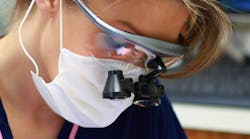There's a hole in your hygiene: How reappointment rates dramatically affect dental practice growth
Let me start out by giving a little bit of information about myself that may lend to the trust you place in my advice. I started in dental consulting and dental data analytics several years ago for a company called Dental Intel. I purchased part of a dental practice called Oxford Dental Care about a year ago and parted ways with Dental Intel.
For years I devoured numbers and trends in the dental industry and helped dentists apply those things in their practices so that they could grow at rates they had not accomplished previously. In our personal practice, we have roughly doubled the previous owner's production within the first year without dramatically increasing the new patient flow. We did this by applying the concepts that I will share with you in this article.
In my years of dental consulting, the biggest issue that I found across the board was reappointing patients. I ran numbers for over 70 dental practices on a daily basis, so I got to see a lot of data. I am confident when I tell you that the most pronounced difference between practices that are collecting over $1,000,000 per year and practices that are collecting closer to $500,000 per year is the hygiene reappointment rate.
The average practice that is collecting in the $500,000 range is reappointing about 60% of all hygiene appointments, while those who are collecting over $1,000,000 are reappointing about 90% of all hygiene appointments. Yes, there are outliers because of other factors like new patient acquisition, treatment mix, etc., but statistically, this is the highest correlating statistic. You may be asking yourself if this really makes a significant difference to the bottom line. I am going to answer that by showing you some hypothetical numbers.
What hygiene reappointment does to practice size
I am going to give you two growth scenarios that are common for practices. Now, I know that by this point a lot of people may be saying, "But I get the patients that I don't reappoint back on the schedule through recall." Let me give you some statistics on this. The average recall system is 25% effective at rescheduling patients.
You might say, "Yes, but we are better than average." To which I would say, "That might be the case, but unless you are tracking it, you really don't know, so let's fix the hole in your hygiene so that you don't have to leave your practice growth to chance." Then I would get off my soapbox and get back to the numbers to hopefully persuade you to make changes that would help you grow your practice dramatically.
Let's assume a few things are constant. Let's assume that you get 30 new patients per month and that we are looking at your practice starting from the first day that you opened the doors. We are going to look at what your growth trend would look like for two different scenarios. Remember that we should be seeing patients no less than two times per year, so this scenario assumes that we see patients every six months.
So, let's get to calculations. Remember, I am a numbers guy, so if I lose you somewhere or if I don't make something clear, ask any questions that you have in the comments part of this article.
I am going to take the patients seen six months ago, multiply that by 60% (reappointment percentage), add back 25% of the 40% not reappointed (assuming an average recall), and add 30 new patients to give us the total number of hygiene patients we get to see in a month.
Jan | Feb | Mar | Apr | May | Jun | Jul | Aug | Sept | Oct | Nov | Dec | |
Year 1 | 30 | 30 | 30 | 30 | 30 | 30 | 51 | 51 | 51 | 51 | 51 | 51 |
Year 2 | 65.7 | 65.7 | 65.7 | 65.7 | 65.7 | 65.7 | 75.99 | 75.99 | 75.99 | 75.99 | 75.99 | 75.99 |
Year 3 | 83.19 | 83.19 | 83.19 | 83.19 | 83.19 | 83.19 | 88.24 | 88.24 | 88.24 | 88.24 | 88.24 | 88.24 |
Year 4 | 91.76 | 91.76 | 91.76 | 91.76 | 91.76 | 91.76 | 94.24 | 94.24 | 94.24 | 94.24 | 94.24 | 94.24 |
Year 5 | 95.96 | 95.96 | 95.96 | 95.96 | 95.96 | 95.96 | 97.18 | 97.18 | 97.18 | 97.18 | 97.18 | 97.18 |
Year 6 | 98.02 | 98.02 | 98.02 | 98.02 | 98.02 | 98.02 | 98.62 | 98.62 | 98.62 | 98.62 | 98.62 | 98.62 |
Year 7 | 99.03 | 99.03 | 99.03 | 99.03 | 99.03 | 99.03 | 99.32 | 99.32 | 99.32 | 99.32 | 99.32 | 99.32 |
Year 8 | 99.53 | 99.53 | 99.53 | 99.53 | 99.53 | 99.53 | 99.67 | 99.67 | 99.67 | 99.67 | 99.67 | 99.67 |
Year 9 | 99.77 | 99.77 | 99.77 | 99.77 | 99.77 | 99.77 | 99.84 | 99.84 | 99.84 | 99.84 | 99.84 | 99.84 |
Year 10 | 99.89 | 99.89 | 99.89 | 99.89 | 99.89 | 99.89 | 99.92 | 99.92 | 99.92 | 99.92 | 99.92 | 99.92 |
This is your growth chart assuming that you reappoint 6 out of 10 patients, have an average recall system, and get 30 new patients per month. You will see that this practice is pretty much plateaued by year 5. Hopefully this is an eye-opening chart. If you are not yet convinced, hopefully the combination of this chart and the next chart will get you there. This next chart assumes everything is the same, except that now 9 out of 10 patients are being reappointed in hygiene.
Jan | Feb | Mar | Apr | May | Jun | Jul | Aug | Sept | Oct | Nov | Dec | |
Year 1 | 30.00 | 30.00 | 30.00 | 30.00 | 30.00 | 30.00 | 57.75 | 57.75 | 57.75 | 57.75 | 57.75 | 57.75 |
Year 2 | 83.42 | 83.42 | 83.42 | 83.42 | 83.42 | 83.42 | 107.16 | 107.16 | 107.16 | 107.16 | 107.16 | 107.16 |
Year 3 | 129.13 | 129.13 | 129.13 | 129.13 | 129.13 | 129.13 | 149.44 | 149.44 | 149.44 | 149.44 | 149.44 | 149.44 |
Year 4 | 168.23 | 168.23 | 168.23 | 168.23 | 168.23 | 168.23 | 185.62 | 185.62 | 185.62 | 185.62 | 185.62 | 185.62 |
Year 5 | 201.69 | 201.69 | 201.69 | 201.69 | 201.69 | 201.69 | 216.57 | 216.57 | 216.57 | 216.57 | 216.57 | 216.57 |
Year 6 | 230.32 | 230.32 | 230.32 | 230.32 | 230.32 | 230.32 | 243.05 | 243.05 | 243.05 | 243.05 | 243.05 | 243.05 |
Year 7 | 254.82 | 254.82 | 254.82 | 254.82 | 254.82 | 254.82 | 265.71 | 265.71 | 265.71 | 265.71 | 265.71 | 265.71 |
Year 8 | 275.78 | 275.78 | 275.78 | 275.78 | 275.78 | 275.78 | 285.10 | 285.10 | 285.10 | 285.10 | 285.10 | 285.10 |
Year 9 | 293.72 | 293.72 | 293.72 | 293.72 | 293.72 | 293.72 | 301.69 | 301.69 | 301.69 | 301.69 | 301.69 | 301.69 |
Year 10 | 309.06 | 309.06 | 309.06 | 309.06 | 309.06 | 309.06 | 315.88 | 315.88 | 315.88 | 315.88 | 315.88 | 315.88 |
Is this real? Yes. Is it affecting you? You should probably find out.In this second scenario, your practice would grow to more than 3X the size of the first with the same new patient flow. In the second scenario, your practice would be bigger by year two than it would be in year 10 of the first scenario. What's more, your practice would still not have plateaued by year 10. So what should you do to make sure that you can grow like the second scenario? I will tell you!
Find out if this is affecting you
Start tracking! There are three ways to track reappointment.
Track it by hand—In my experience, unless you have someone who will be holding the person in charge of tracking accountable, this will likely not happen. If you feel that your staff is different, by all means, give this a try. Keep track of the reappointment rate in a spreadsheet. Make a column for hygiene patients seen and then hygiene patients rescheduled and the date they were rescheduled for. The date is so that you can audit these numbers occasionally to make sure that you are getting accurate, unadulterated data.
Pull reports from your practice management software—This number is readily available in most practice management software. If it isn't available in yours, you should probably look at finding a new software where it is available, considering that this statistic alone can affect your practice size by over 300%.
Invest in an automated software that will do this for you—There are several of these available for a few hundred dollars a month. If the other methods are not working for you, a few hundred dollars will likely provide a good return on investment if you can make some improvements.
Now that you know if this is affecting you, let's talk about how to improve the number. Remember, this could be hundreds of thousands of dollars per year difference if you perfect the reappointing process.
Follow the leaders
There are several different methods for reappointing hygiene patients. In my time as a dental analyst and consultant I saw just about every way you can think of. Sometimes it is done by the hygienist in the hygiene room. Sometimes patients are reappointed by the assistant in the hygiene room. Sometimes patients are reappointed at the front desk by a front office person. Sometimes they are handed off to the front office person and sometimes they are just sent to the desk. I think you are starting to see that there are a lot of variables. So I want to break the success down statistically. (Remember, I'm a numbers geek.) This should give you the highest likelihood of success in reappointing.
The variables that correlated the strongest with reappointment percentage were:
1. Complimenting the patient for something related to oral health immediately prior to reappointing.
2. Reappointing by the hygienist.
3. Phrasing as a statement not a question. For example, "Let's get your six month cleaning scheduled," as opposed to, "Do you want to schedule your next appointment?"
4. Telling the patient what most people like to do. For example: "Most people like to schedule their appointments six months out so that we remind them when the time comes. This gives them one less thing they have to try to remember."
If you are not doing these things and your reappointment numbers are struggling, you will see an immediate increase by implementing these things.
Find out how well you are reappointing. Don't guess!Monitor this number daily and make your hygienist responsible for getting it to where it needs to be. Implement the variables that correlated with the most successful practices and watch your numbers grow!
About the Author

Adam Smith
Co-Owner, Oxford Dental Care
Adam Smith is part owner of Oxford Dental Care and has personally consulted with more than 70 dental practice across the United States and Canada. He worked as a consultant and a data analyst with Dental Intel, where he fell in love with the statistics and business aspect of dentistry. He can be reached at [email protected].
Updated April 17, 2017
